Dell EMC PowerEdge T340 Compute Performance
For this exercise, we are using our legacy Linux-Bench scripts which help us see cross-platform “least common denominator” results we have been using for years as well as several results from our updated Linux-Bench2 scripts. At this point, our benchmarking sessions take days to run and we are generating well over a thousand data points. We are also running workloads for software companies that want to see how their software works on the latest hardware. As a result, this is a small sample of the data we are collecting and can share publicly. Our position is always that we are happy to provide some free data but we also have services to let companies run their own workloads in our lab, such as with our DemoEval service. What we do provide is an extremely controlled environment where we know every step is exactly the same and each run is done in a real-world data center, not a test bench.
We are going to show off a few results, and highlight a number of interesting data points in this article.
Python Linux 4.4.2 Kernel Compile Benchmark
This is one of the most requested benchmarks for STH over the past few years. The task was simple, we have a standard configuration file, the Linux 4.4.2 kernel from kernel.org, and make the standard auto-generated configuration utilizing every thread in the system. We are expressing results in terms of compiles per hour to make the results easier to read:
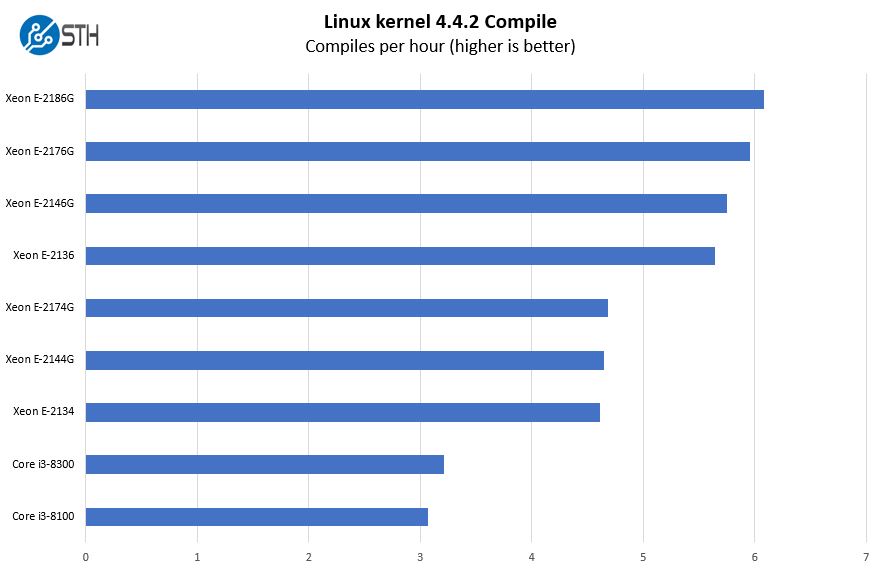
Perhaps the biggest change in this iteration of the Intel Xeon E-2100 series underpinning the Dell EMC PowerEdge T340 is that the series now has six cores. We covered the about decade long history of the CPUs in this segment in our piece: Looking back at Intel Xeon E3-1200 V1-V6 to the New Xeon E-2100. The six core, twelve thread parts perform extremely well and are a generational leap in performance over the Intel Xeon E3-1200 V6 series. If you have a competitor still quoting the Intel Xeon E3-1200 V6 series, they are no longer offering competitive performance against the newer six-core models.
c-ray 1.1 Performance
We have been using c-ray for our performance testing for years now. It is a ray tracing benchmark that is extremely popular to show differences in processors under multi-threaded workloads. We are going to use our 8K results which work well at this end of the performance spectrum.
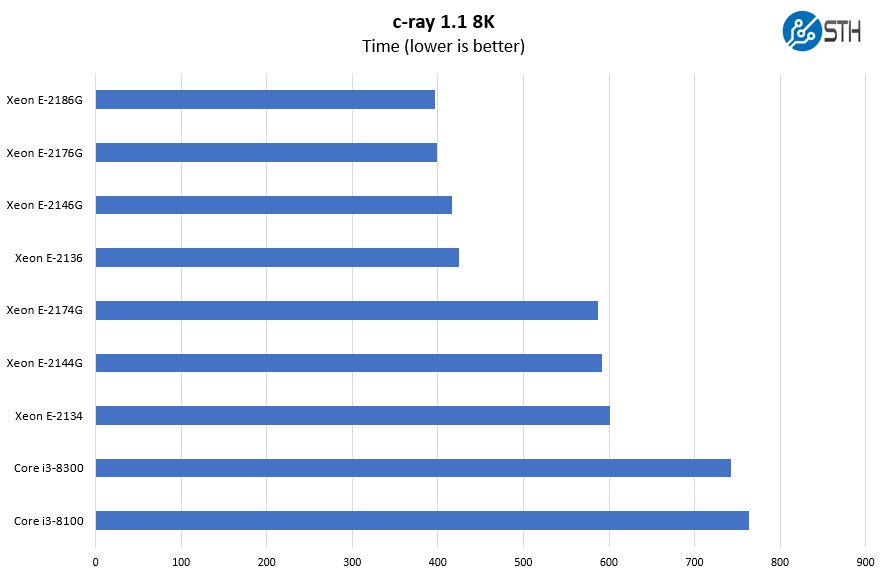
For budget-conscious Dell EMC PowerEdge T340 shoppers, there are a number of lower-priced options available, including the Intel Core i3-8100 and Intel Core i3-8300. These have four cores and four threads and still very respectable mid-3GHz clock speeds.
7-zip Compression Performance
7-zip is a widely used compression/ decompression program that works cross-platform. We started using the program during our early days with Windows testing. It is now part of Linux-Bench.
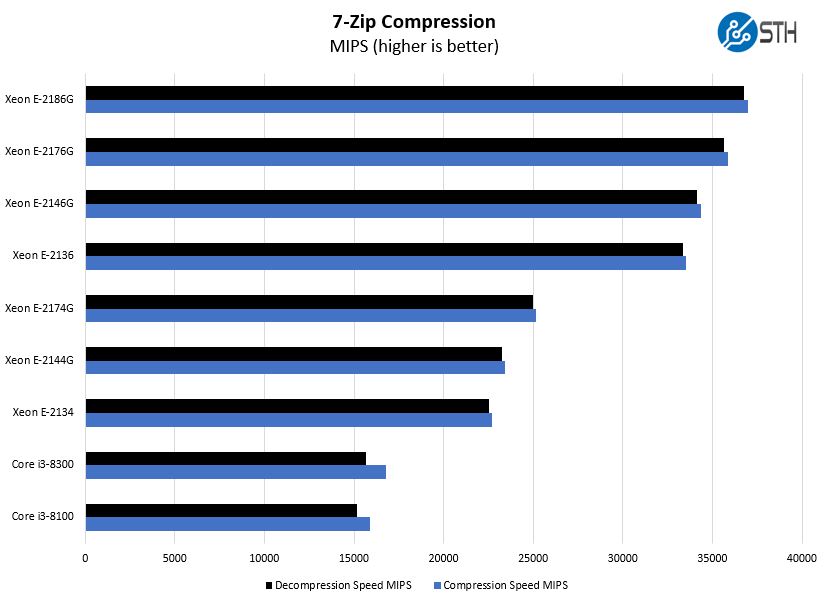
Compression is a common task for modern servers. Here the six-core options like the Intel Xeon E-2186G offer great performance for the PowerEdge T340.
Sysbench CPU test
Sysbench is another one of those widely used Linux benchmarks. We specifically are using the CPU test, not the OLTP test that we use for some storage testing.
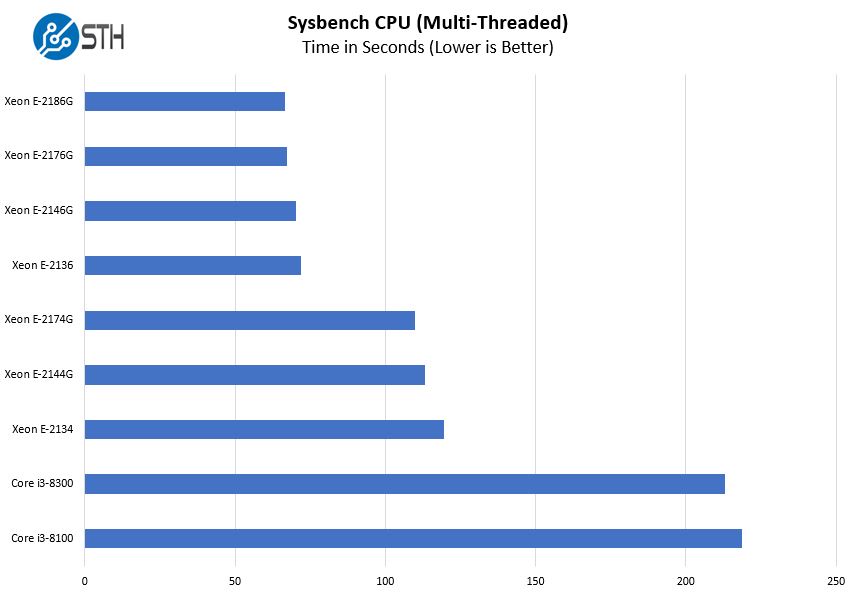
Integrated GPUs can be helpful for features such as video transcoding. Those parts have the “G” suffix appended. If you do not need the graphics engine, the Intel Xeon E-2136 is priced competitively as the entry six core, twelve thread CPU option. Usually, after discounts on the PowerEdge T340, our top pick of the lineup the Intel Xeon E-2146G is a nominal upgrade that we suggest selecting that model.
OpenSSL Performance
OpenSSL is widely used to secure communications between servers. This is an important protocol in many server stacks. We first look at our sign tests:
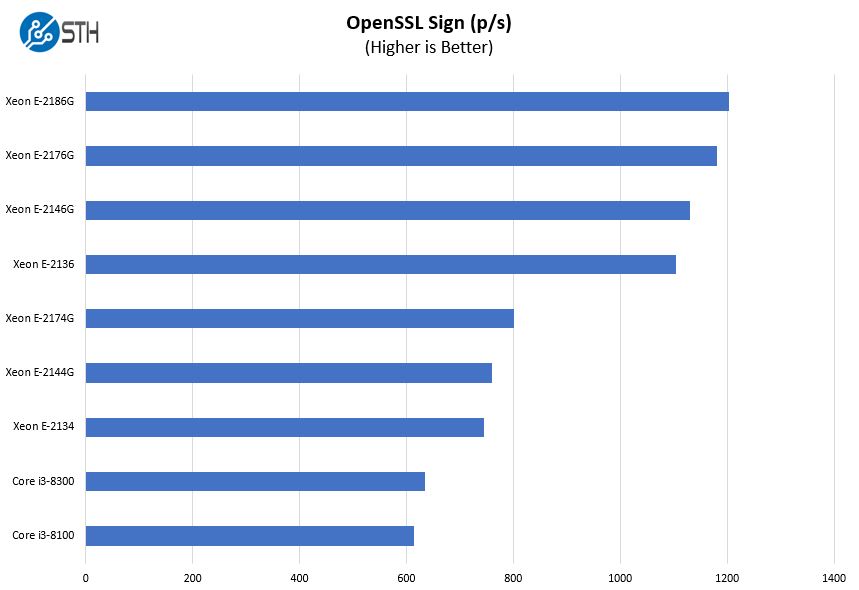
Here are the verify results:
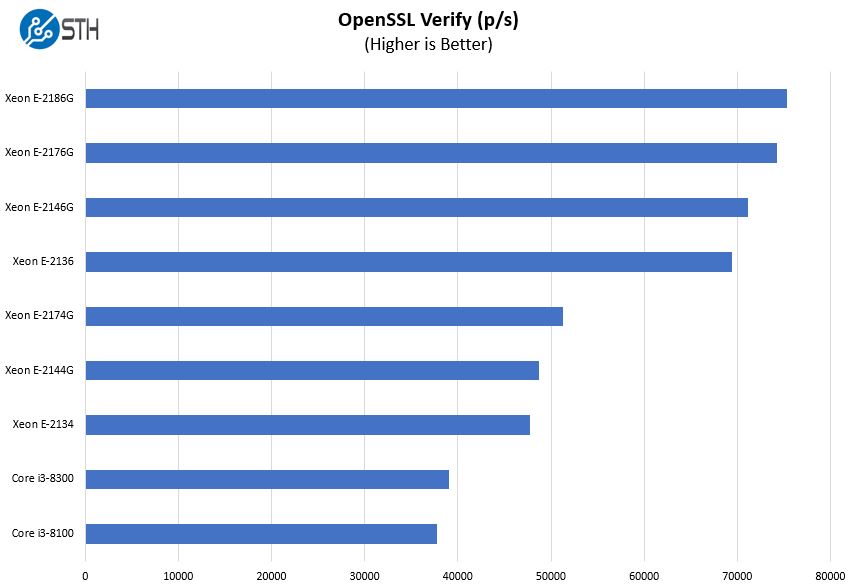
OpenSSL is a fundamental workload. One can see that the jump from four cores and threads to four cores eight threads are much less substantial than the jump to the six core parts. That is why we suggest that if you need or want CPU performance in the Dell EMC PowerEdge T340, you should opt for the higher-end SKUs.
UnixBench Dhrystone 2 and Whetstone Benchmarks
Some of the longest-running tests at STH are the venerable UnixBench 5.1.3 Dhrystone 2 and Whetstone results. They are certainly aging, however, we constantly get requests for them, and many angry notes when we leave them out. UnixBench is widely used so we are including it in this data set. Here are the Dhrystone 2 results:
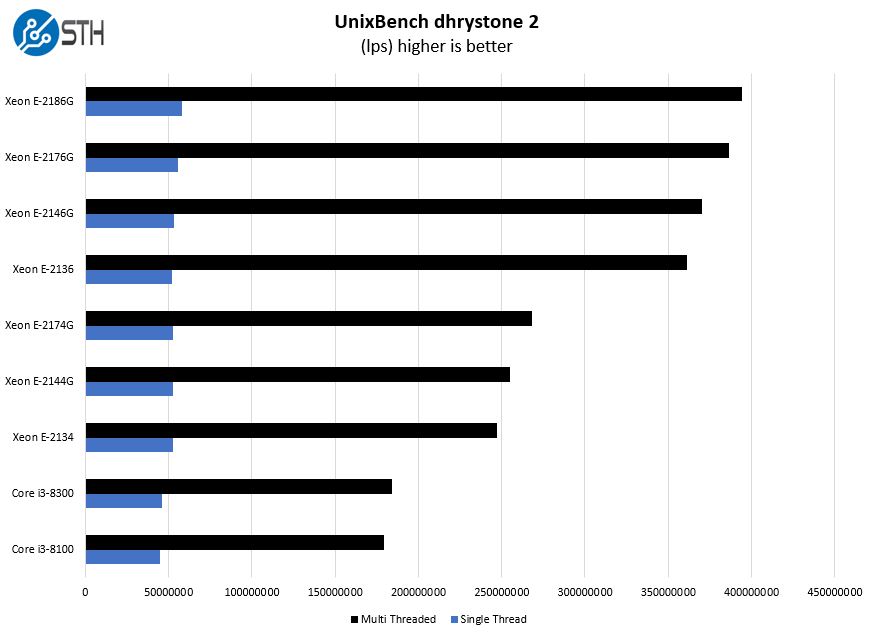
Here are the whetstone results:
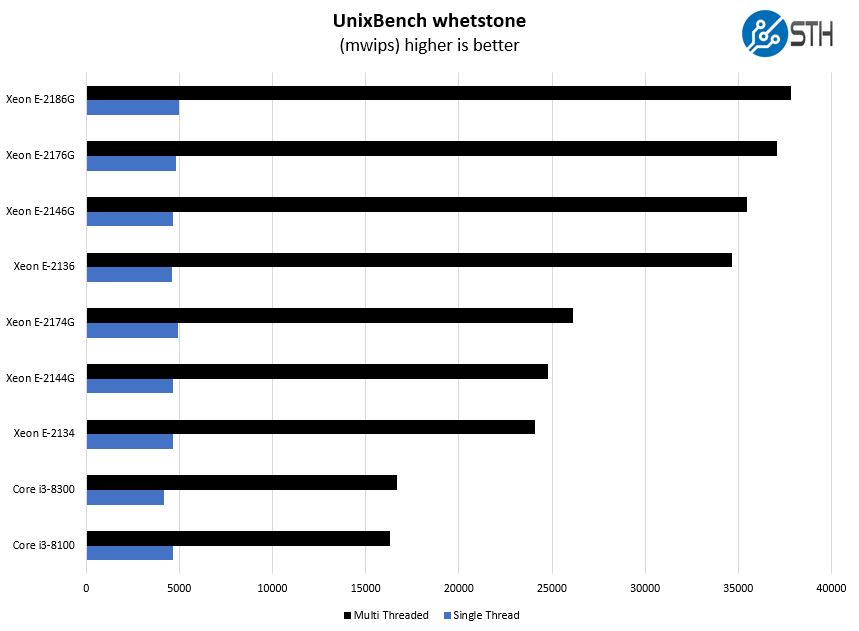
Moving from Core i3 to Xeon E-2100 also provides higher clock speeds. That helps in many workloads that are limited by the performance of a thread. While the Intel Celeron and Intel Core i3 parts may save a few dollars on the PowerEdge T340 configuration, if you may be performance bound it is better to get the higher-end part.
Chess Benchmarking
Chess is an interesting use case since it has almost unlimited complexity. Over the years, we have received a number of requests to bring back chess benchmarking. We have been profiling systems and are ready to start sharing results:
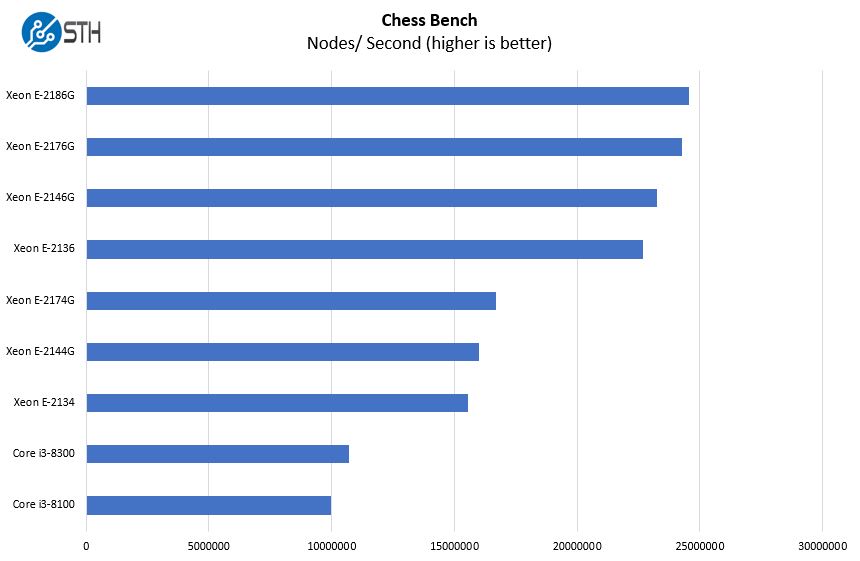
Here we are getting a noticeable bump from the higher clock speeds and hyper-threading found on the Intel Xeon E-2100 series parts over the Core i3 parts. Not every workload is this dramatic, but when shopping for a CPU for your Dell EMC PowerEdge T340, keep in mind that there are some cases of very large performance differences.
Next, we are going to show power consumption and give our Dell EMC PowerEdge T340 review a wrap-up.




To use 8×3.5 hard drives (total), do you need a card like the LSI SAS 9211-8i to utilize a second 4×3.5 drive cage?
I have a Lenovo TS440 – the first 4×3.5 SAS connector is on the motherboard, the second 4×3.5 expansion kit required me to acquire the LSI card. Thanks,
Nothing says hands on review quite like a discussion about the cover latch. Classic STH!
I wonder why they made this server so big. Most companies are trying to make things more compact. You could have mentioned that the bigger size isn’t good for office managers. If it takes up another half a square foot that’s several dollars a month for space which you’ve gotta add in TCO calculations.
It looks SIIIIIICK though! Like a tank of a server.
So…Based on this review…
I’m guessing it’s big? O_o
lol
You do realize the size has been the same for generations now and is due to being able to rack mount it.
I was pricing one of these machines on the Dell website (large corporate or IT buyers generally not using such means) last night and disappointed that everything today is ala carte pricing and even for mundane items one should not have to pay for to have included with any computer e.g. technical document on DVD.
Such approach to “one of” sales not the mindset what made Dell famous in the USA or why it was Dell even developed a large custom base during a period of high hardware competition choices (1990-2000). My first Dell up right computer was a dual Pentium Pro, my last Dell up right a dual P4, afterwards changing brands.
Worst, Dell’s ala carte pricing is driven in part by an unrealistic desire for constant, exponential revenue growth regardless of unit sales increase, a.k.a. corporate greed predicated on non equilibrium economic models, thus fitted with arbitrarily high retail pricing of an abusive nature rather than projecting an innate desire to benefit every day Americans, the Dell machine not assembled in the USA as should be, but Mexico.
The pricing schedule today, rather than in the past, when much of the pricing was premised more about a 1:1 product offering of a substituting nature, e.g. not having to over pay for intentionally proprietary (high profit margin for integrator and Apple ethos) hardware, with Dell no longer incorporating name brand OEM provider components and mountings as was their former Dell Sony displays, Dell Adaptec RAID controller… is ripe today for over pricing such as the minimalist Dell PERC to excessive pricing for Dell case front bezel.
To close, the motherboard in this computer, rather than designing a upright computer case that opens from the left (seen face on), is inverted top to bottom, thus not a proper mounting solution, but a disrespectful engineering short cut (hack) since this motherboard per peripheral slot direction, is intended to be oriented in the opposite (peripheral slots to the left, not right) direction. The purpose of the orientation is to prevent dust from accumulating onto the top (primary component side) surface of peripheral slot mounted PC board along with reduced thermal evacuating efficiency should the computer case be placed in an upright position and given situation in the photo, with dust potentially accumulating onto the top side of the PERC heat sink.
Park McGraw
Side note, I have not liked the manner in which a full size upright Dell computer case opens, since my dual P2.
Anybody know what the metal cage looking thing in the top right (in front of the psu) is for?
[refering to picture “Dell EMC PowerEdge T340 Internal Without Shroud”]
It looks HUGE! Was this designed for the China market where they like everything big? The cable routing is a mess, it looks over-complicated. Yes, you will need a card to support the additional drives beyond 4 drives.
Does this Server support puce bifurcation? I want to add a dual M.2 card for dual NVMe with the x8 slot. Such a card exists from Supermicro, but need PCIe bifurcation.
Otherwise I can only add 1 NVMe card per slot instead of 2. Not many free slots in this Server :-(
I wonder if this server has / will get bios support for Intel Xeon E-2278G?
That would make a great upgrade. But I fear processors are whitelisted.
Any chance you folks have revisited the T340 now that it’s been roughly a year and tried putting 128GB of RAM in it despite no word from Dell on it.
Can you update us on if the T340 now supports 128GB of RAM?
Same question, someone have tried 128GB? Thank you!
Does anyone know what BIOS settings are needed to hit the 41W idle mentioned in the review?